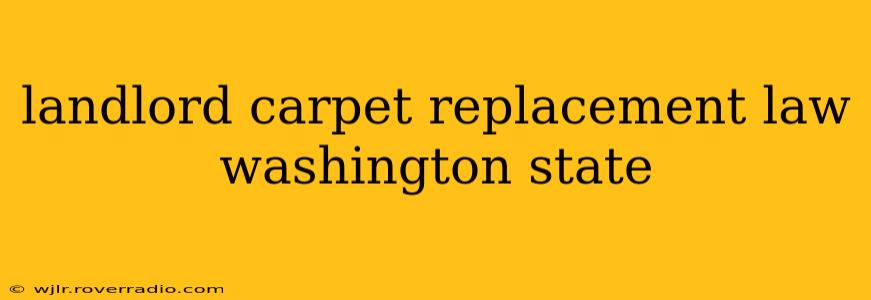Landlords in Washington State have responsibilities regarding the condition of their rental properties, including carpeting. While there isn't a specific law mandating carpet replacement at a certain interval, Washington's landlord-tenant law hinges on the concept of habitability. This means landlords must provide and maintain a dwelling that's fit for human occupancy. Let's delve into the specifics.
What are Washington State's Laws Regarding Carpet Replacement?
Washington State law doesn't prescribe a timeframe for carpet replacement. Instead, the focus is on whether the carpet's condition affects the property's habitability. If the carpet is significantly worn, damaged, or poses a health hazard (e.g., severe mold or pest infestation), a landlord might be legally obligated to replace it. The determining factor is whether the condition breaches the implied warranty of habitability.
This warranty is implied in every rental agreement and requires landlords to:
- Provide a safe and clean living space: This includes addressing significant carpet issues that compromise health or safety.
- Maintain essential systems and appliances: While not directly related to carpet, this principle highlights a landlord's overall responsibility for maintaining a habitable dwelling.
- Respond to tenant's repair requests in a timely manner: If tenants report damaged or unsanitary carpeting, the landlord has a duty to address the issue.
How Do I Know if My Landlord Needs to Replace the Carpet?
Determining whether your landlord must replace the carpet involves assessing the extent of the damage and its impact on habitability. Consider these factors:
- Extent of damage: Is the carpet severely stained, ripped, or worn down to the padding? Minor wear and tear might not be grounds for replacement, but extensive damage certainly could be.
- Health and safety concerns: Does the carpet harbor mold, mildew, or pests? These issues pose significant health risks and could necessitate immediate replacement.
- Impact on habitability: Does the carpet's condition make the unit unpleasant or unsafe to live in? This is the crucial question.
What if My Landlord Refuses to Replace the Carpet?
If you believe your landlord is violating the implied warranty of habitability due to the condition of the carpeting, you have several options:
- Document the issue: Take photos and videos of the damaged carpet as evidence. Keep records of all communication with your landlord.
- Submit a written repair request: Send your landlord a formal written request detailing the problem and requesting repair or replacement. Keep a copy of the request for your records.
- Contact your local housing authority: They can investigate your complaint and potentially take enforcement action against your landlord.
- Consult with a tenant rights organization: They can provide advice and support regarding your rights and options.
- Withhold rent (use caution): Withholding rent is a risky strategy and should only be done as a last resort and in accordance with state law. Consult with an attorney before taking this step. Improperly withholding rent can lead to eviction.
What if the Carpet is Damaged Due to Tenant Negligence?
If the carpet damage is directly attributable to tenant negligence (e.g., significant spills that weren't cleaned promptly, intentional damage), the landlord may not be obligated to replace it. However, the extent of the tenant's responsibility is a matter of interpretation and could depend on the specifics of the lease agreement.
Is there a specific clause in my lease about carpet replacement?
Your lease agreement might contain clauses addressing carpet maintenance or damage. Carefully review your lease to see if it addresses these issues. If it does, these clauses will likely supersede the general implied warranty of habitability regarding the carpet's condition.
How can I determine if the carpet is a health hazard?
If you suspect mold, mildew, or pest infestation in the carpet, it is crucial to document this thoroughly with photos and videos. You might consider contacting a qualified professional (e.g., mold inspector or pest control specialist) to assess the situation and provide a written report. This professional report will strengthen your case if you need to pursue further action with your landlord.
Remember, navigating landlord-tenant disputes can be complex. If you're unsure about your rights or need legal advice, it’s always best to consult with a tenant rights organization or an attorney specializing in landlord-tenant law in Washington State. This information is for general guidance only and does not constitute legal advice.
